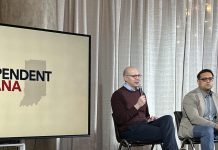Gavel Gamut By Jim Redwine
www.jamesmredwine.com
(Week of 03 July 2017)
ARE WE STILL SEPARATE?
Although I wrote the first few Gavel Gamuts in 1990 the every-weekly column began in April 2005, about 700 articles ago. In light of our current political and cultural dissonance I thought it might be interesting to revisit the following thoughts from over a decade ago to assess what changes may have occurred. This Birthday Greeting to America was first published July 04, 2005. I hope those of you who read it then and those who are considering it for the first time will find it worthwhile in our on-going conversation of Separate versus Equal. Also, Peg and I are returning to Osage County, Oklahoma for this Fourth of July. Maybe we’ll find the bus station is now just a memory.
Happy Birthday to U.S.!
Let’s Have a Party and Invite Everyone!
The United States Supreme Court has occasionally succumbed to popular opinion then later attempted to atone for it. The Dred Scott (1857) and Plessy v. Ferguson (1892) cases come to mind as examples of institutionalized injustice with the partial remedy of Brown v. Board of Education (1954) being administered many years later.
In Dred Scott, the U.S. Supreme Court decided that American Negroes had no rights which the law was bound to protect as they were non-persons under the U.S. Constitution.
And in Plessy, the Court held that Mr. Plessy could not legally ride in a “whites only†railroad car. The Court declared that laws that merely create distinctions but not unequal treatment based on race were constitutional. SEPARATE BUT EQUAL was born.
Our original U.S. Constitution of 1787 disenfranchised women, and recognized only three-fifths of every Black and Native American person, and even that was only for census purposes. Our Indiana Constitution of 1852 discouraged Negro migration to our state in spite of Posey County Constitutional Convention Delegate, Robert Dale Owen’s, eloquent pleas for fair treatment for all.
Were these documents penned by evil men? I think not. They were the result of that omnipotent god of politics, compromise, which is often good, but sometimes is not. Should you have read this column recently you may recall that I strongly encourage compromise in court, in appropriate cases.
However, as one who grew up in a state where the compromise of the post Civil War judges and politicians led to the legal segregation of schools, restaurants, and public transportation, I can attest that some compromises simply foist the sins of the deal makers onto future generations.
When I was 6 years old, my 7 year old brother, Philip, and I made our first bus trip to our father’s family in southern Oklahoma.
We lived on the Osage Indian Nation in northeastern Oklahoma. It sounds exotic but our hometown, Pawhuska, looked a lot like any town in Posey County.
In 1950 our parents did not have to worry about sending their children off with strangers except to admonish us not to bother anyone and to always mind our elders.
When mom and dad took us to the MKT&O (Missouri, Kansas, Texas and Oklahoma) bus station it was hot that July day. Oklahoma in July is like southern Indiana in July, WITHOUT THE SHADE TREES!
My brother and I were thirsty so we raced to the two porcelain water fountains in the shot gun building that was about 40 feet from north to south and 10 feet from east to west.
Phil slid hard on the linoleum floor and beat me to the nearest fountain. And while I didn’t like losing the contest, since the other fountain was right next to the first one, I stepped to it. “Jimmy, wait ‘til your brother is finished. James Marion! I said wait!†Dad, of course, said nothing. He didn’t need to; we knew that whatever mom said was the law. “Mom, I’m thirsty. Why can’t I get a drink from this one?â€
brother up there.â€
Of course, the next thing I wanted to do was use the restroom so I turned towards the four that were crammed into the space for one: “White Menâ€, “White Ladiesâ€, “Colored Menâ€, and “Colored Womenâ€. After mom inspected us and slicked down my cowlick again, we got on the bus and I “took off a kiting†to the very back.
I beat Phil, but there was a man already sitting on the only bench seat. I really wanted to lie down on that seat but the man told me I had to go back up front. And as he was an adult, I followed his instructions.
Philip said, “You can’t sit back there. That’s for coloreds. That’s why that colored man said for you to go up front.â€
That was the first time I noticed the man was different. That was, also, the point where the sadness in his eyes and restrained anger in his voice crept into my awareness.
As a friend of mine sometimes says, “No big difference, no big difference, big difference.â€
And if all this seems as though it comes from a country far far away and long long ago, Posey County segregated its Black and White school children for almost 100 years after 600,000 men died in the Civil War. In fact, some of Mt. Vernon’s schools were not fully integrated until after Brown was decided in 1954.
And, whether we have learned from our history or are simply repeating it may depend upon whom we ask. Our Arab American, Muslim, Black, Native American, and Hispanic citizens, as well as several other “usual suspectsâ€, may think the past is merely prologue.
Sometimes it helps for me to remember what this 4th of July thing is really about. It’s our country’s birthday party; maybe we should invite everyone.
There is nothing equal about separate.
EDITOR FOOTNOTE: For more Gavel Gamut articles go to:
www.jamesmredwine.com





